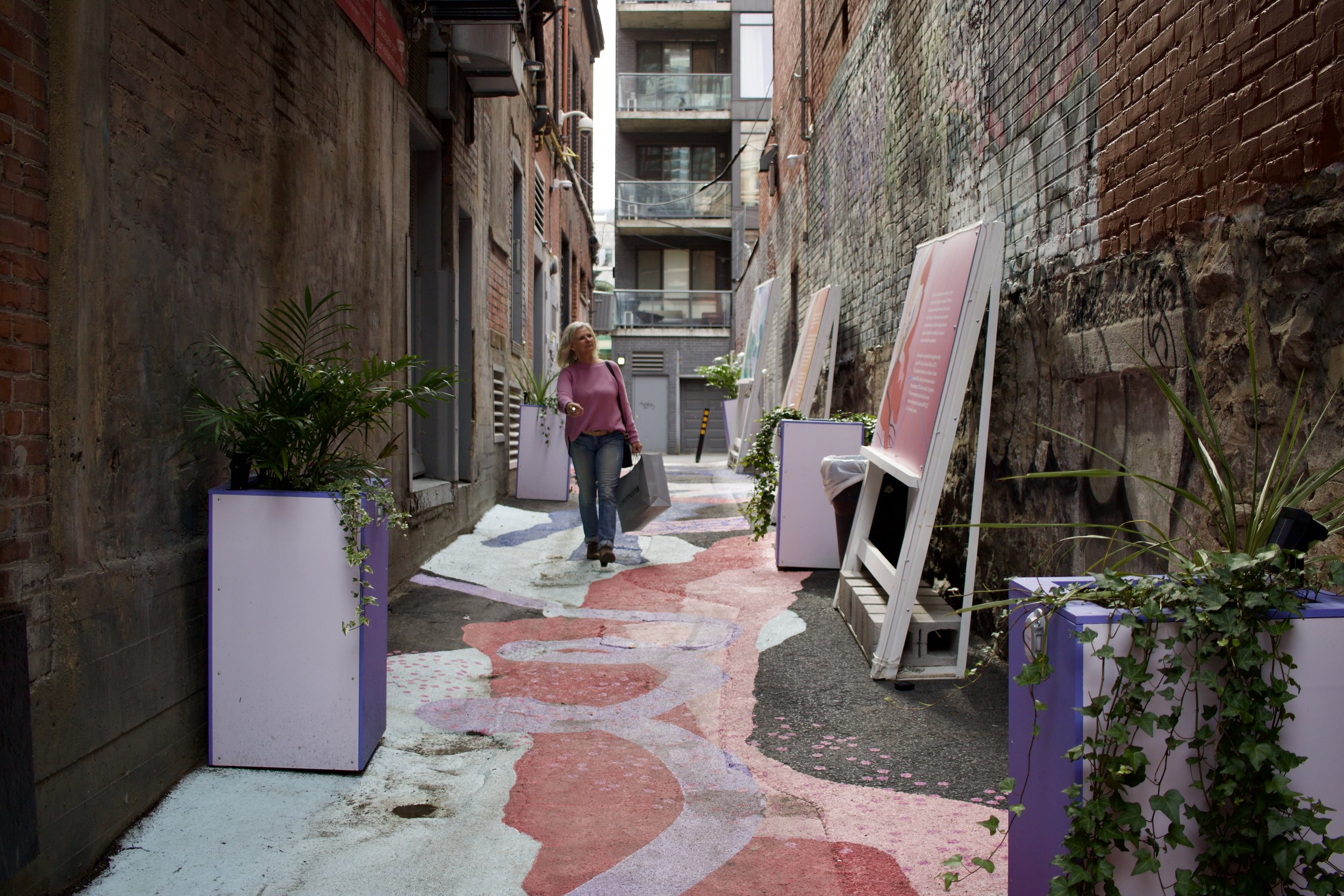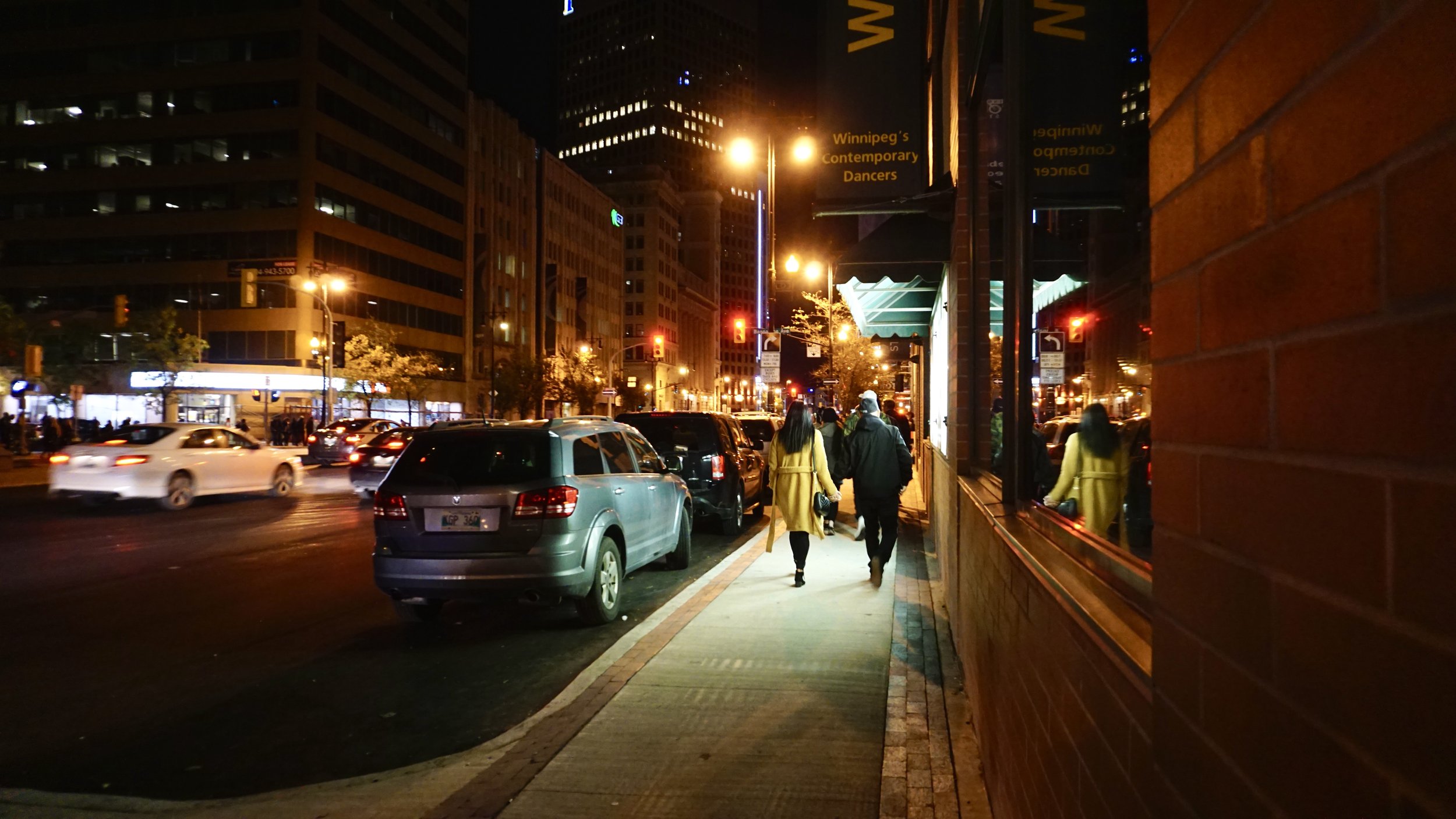How to get Harassment off our Streets
Two women walking along Saint-Catherine Street in Montreal, QC beside a parklet with additional women sitting (photo by Nicole Roach 2022)
Before heading out, many women consider what they’re wearing, what route they are taking, and what time of day they are going to be traveling in an effort to reduce their risk of street harassment and gender-based violence. Even when women take steps to mitigate their risk, unwanted attention can be unavoidable. That’s because it doesn’t matter what a woman is wearing, where she is, or what time of day it is - any woman can be a target.
In Canada, 33% of women have experienced unwanted sexual behaviour in public, which can include unwanted comments, gestures, and actions. This is partly attributed to our patriarchal society that views women as “public spectacles”, implying that women existing in public is a performance for the benefit of others, a display that is deliberately “inviting” the attention and admiration of men.
In addition to gender-based harassment, many people are publicly harassed because of their race, sexuality, nationality, religion, class, or disability, sometimes experiencing harassment for multiple things. This means that women of colour, women with disabilities, or poor women are at additional risk for unwanted attention. While these sexist systems play a major role in street harassment, so does the way we design our cities.
The Types of Street Harassment Reported by Gender (Source: Stop Street Harassment, 2014)
Transforming cities to have more eyes on the streets, stronger community ties, more welcoming public spaces, better lit streets and paths, widened sidewalks, more frequent public transit, and fewer personal vehicles can have an impact in reducing gender-based street harassment. Here are a few design strategies that can help Canadian cities get harassment off the streets.
Having More Eyes on Streets
Many women are fearful of public spaces that are seen as empty, with no “friendly faces” around. This is prevalent in some downtown or industrial areas that attract people during the day for work, and are left desolate shortly after 5 pm. The lack of people can be linked to crime rates, with no one around to witness harassment or even to intervene.
People gathered in the Exchange District during Nuit Blanche in Winnipeg, Manitoba (photo by Nicole Roach, 2019)
It was Jane Jacobs who theorized that prioritizing urban development that keeps bystanders out on the streets at nearly all times of day and night is the most effective way to ensure that neighbourhoods are well “watched” by community members, helping to reduce sexual harassment and gender-based violence. This is what many urbanists are trying to encourage through measures like mixed-use and human-scaled design. Eyes on the street can also be supported by community programming, inclusive placemaking, and neighbourhood “watch” or walk home initiatives.
Fostering Community
More eyes on the street can certainly help to deter street harassment and unwelcome attention, but in certain cases, people are just watching these interactions take place. Sometimes people do not have the tools to intervene, they do not see it as anything serious (it’s just a compliment, right?), or they simply do not care. Whatever their reason, it is a terrible feeling to experience harassment while surrounded by people that are not making any efforts to help - especially those “good guys”!
People witnessing harassment need to recognize that they are neighbours and potentially allies to someone in need. This requires building communities that actually foster community, where even casual interactions contribute to a collective sense of belonging and duty to one another. This can be achieved through dense, walkable neighbourhoods with well-supported community spaces, services, and programming. Furthermore, bystander intervention training should be more widely available for anyone to take and strongly recommended for people in community leadership positions. This training can help anyone to support the target by pretending you’re a friend, distracting the harasser, or asking the victim afterwards if they are okay or would like company.
Opening up Public Spaces
Many cities have claustrophobic and enclosed designs that block access, sound, and visibility. For example, pedestrian tunnels, overgrown trails, or closed off staircases. Many women strive to avoid these kinds of places entirely, and those who are unable to avoid them may experience higher rates of harassment or violence. It is these places that dictate what routes women take, who they go with, and the kinds of fear they may experience in their daily lives.
Woman walking down alleyway that has been enhanced with public art, plants, and signage in Ruelle Stanley in Montreal, QC (Photo by Nicole Roach, 2022)
Making places more open and visible will help to deter sexual harassment, and in instances where the offender is not deterred, it will hopefully provide opportunities for bystanders to intervene or report the incident. This can be achieved by making bus stops with clear glass and providing multiple points of entry. Building facades can also be made transparent, especially in public stairwells. Additionally, these kinds of spaces should be revitalized, using public art, greenery, and programming to make them more animated, welcoming, and safe for everyone.
Lighting up the Streets
Many women have been conditioned to not be out alone at night because of the potential threats lurking in dark alleys, behind dumpsters, or anywhere else. Dark spaces can create dangerous environments for women, limiting their ability to assess risks and reducing visibility for witnesses/bystanders. This is often a consideration for the lighting of main routes, however, there are many dimly lit side streets or paths that women still need to access at all times of the day.
Lighting up all routes at night allows women to go where they need to go, without significantly altering their route due to potential threats. This is also important for creating a pleasant ambiance in neighbourhoods and activating public spaces, such as utilizing string lights, multi-coloured lighting, or lights at varying height levels. Lighting should be used in a way that creates a welcoming atmosphere in the evenings (not excessively bright spotlights that deter the presence of houseless neighbours), provides eyes on the streets, and allows women the freedom to choose their desired route.
Widening the Sidewalks
Plenty of city sidewalks are narrow to begin with, and made narrower when restaurant or pub goers are spilling out onto the sidewalk. This design can lead to large groups of men (often intoxicated) taking up a considerable amount of the public space and making it uncomfortable or even dangerous for a woman walking past. It’s a fine line walking past - on one side you may have rowdy men yelling out catcalls at you, and on the other side you may have fast-moving vehicles - nowhere safe to go.
Couple walking on narrow sidewalk in downtown Winnipeg, MB (Photo by Nicole Roach 2019)
Creating more space for sidewalks and public seating provides essential space for women to distance themselves from harassers, which can also help reduce the risk of escalation. Wider sidewalks that are lined with trees, plants, and benches also help to support other measures, such as getting more eyes on the street and fostering community. This can easily be achieved by removing parking spaces and vehicle lanes, or even turning commercial streets into zero-emission zones.
Creating Better Public Transit
Public transit can create high-risk situations for many women, whether waiting for a bus, train, or subway, or being on one. Even the absence of transit can have an impact, as research has shown that locations with fewer transit route options have more frequent incidents of harassment. In any case, women are often confined in a space, unable to leave the stop/platform, or they are stuck between stops. It is no wonder that fear of harassment on public transit leaves many women looking for alternatives.
A solution can be providing more transportation options for women, such as more buses/trains/subways, going to more places, much more often. This would give women the freedom to leave uncomfortable situations, knowing that another ride will come in five minutes or a similar route is available only a short walk away. Transit cars and buses can also be designed to feel more joyful and community-oriented using creative space configurations and artwork, encouraging healthy, non-intrusive interactions between passengers.
Getting Harassers out of Vehicles
Men in vehicles, especially groups of cishet men, in large trucks, and with misogynistic bumper stickers (or truck balls - yuck!), are often emboldened when behind the wheel. They are able to honk and/or yell at someone on the sidewalk/bike lane then quickly speed away so that the target would not be able to catch up or “hollaback”. Oftentimes, this sexual harassment from a vehicle can be paired with road violence, such as revving the engine, rolling coal, excessive honking, close passing, or even running a person over.
Woman walking towards car-free zone on Saint-Catherine Street in Montreal, QC (Photo by Nicole Roach)
While a driver may still be motivated to harass someone outside of a vehicle, they are stripped of relative anonymity, no longer have an easy escape, and do not have a half-ton weapon at their immediate disposal. Of course, you can’t really target harassers by removing them from their vehicles, but instead, cities must prioritize multi-modal transportation and make driving less convenient and desirable for everyone. Some measures for this can be increased gas taxes, commuting fees, parking costs, road closures, zero-emission zones, and much more.
Design Doesn’t Go Far Enough
This piece has presented numerous design interventions, programs, and policies that can help reduce gender-based street harassment in cities. However, we recognize that transformative design can only go so far in making women feel comfortable and safe in public spaces. As said by Strong Towns, “hard conversations with men and boys won’t be replaced by sidewalk chalk and block parties”.
Accordingly, we must also work to change the patriarchal society that has negatively shaped men’s behaviour towards women. This is part of a long-standing battle for gender equality, which also includes the fight for bodily autonomy, affordable childcare, equal pay, protection of Indigenous women and girls, equal access to quality healthcare, and so many more important intersectional feminist issues.
We hope that transforming cities can help to achieve greater gender equality in all aspects of our lives, especially in ways that empower women to wear what they want, go where they want, and travel when they want - without fear.
Canadian women certainly deserve that, right? Let’s get to work.
Resources
https://stopstreetharassment.org/about/what-is-street-harassment/
https://www.theguardian.com/world/2022/may/16/street-harassment-women-public
https://www.theglobeandmail.com/canada/toronto/article-designing-safer-cities-for-women/
https://canadianwomen.org/blog/street-harassment-isnt-a-compliment/
https://www.strongtowns.org/journal/2017/5/31/can-city-design-help-end-street-harassment
https://ebelding.cs.ucsb.edu/sites/default/files/publications/sig-alternate.pdf
https://www.strongtowns.org/journal/2016/4/20/woman-public-transit-harassment







